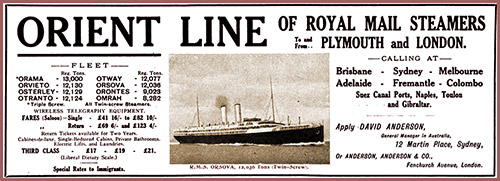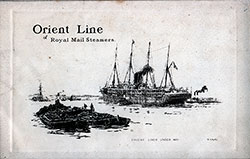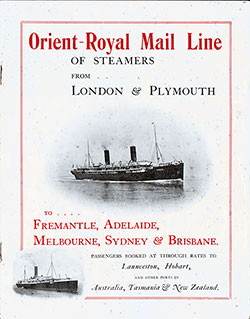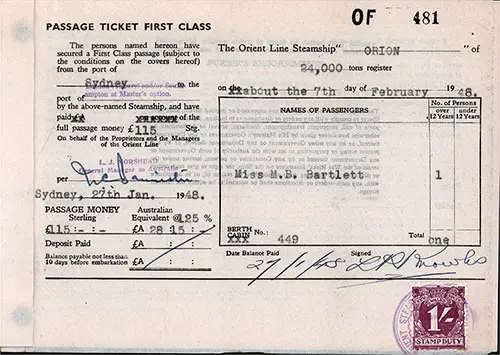The Orient Line Archival Collection: A Legacy of Transoceanic Mail, Migration, and Luxury Travel
Established in 1878, The Orient Line of Royal Mail Steamers played a pivotal role as the contractors with the Commonwealth Government for mail carriage between England and Australia. Their fortnightly service, a lifeline connecting the two distant lands, is maintained from London, calling at Plymouth, Gibraltar, Marseilles, Naples, Port Said, Suez, Colombo, Fremantle, Adelaide, Melbourne, Sydney, and Brisbane.
Rapid strides have been made in passenger service by The Orient Line. They have not only reduced the passage from 55 to 33 days but also provide excellent accommodation to long-distance travelers, making the journey a comfortable and convenient experience.
In 1901, the Ophir, a vessel of grandeur and historical significance, was selected for her sea-going qualities and specially fitted for H.R.H. the Prince of Wales. This was a momentous occasion as the Prince, accompanied by the Princess, visited Australia to open the first Parliament of the Commonwealth, a testament to the grandeur and significance of the Orient Line's services.
Explore the Orient Line’s rich maritime history, from its role in mail transport between England and Australia to its luxurious passenger voyages. This archival collection features passenger lists, brochures, and travel documents spanning 1878-1954, making it a valuable resource for historians, genealogists, and maritime enthusiasts.

Advertisement for the Orient Line of Royal Mail Steamers. Australia Today, 1 November 1912. | GGA Image ID # 1d4249fb60
Transcript of 1912 Advertisement
ORIENT LINE OF ROYAL MAIL STEAMERS To and From PLYMOUTH and LONDON.
— CALLING AT — Brisbane - Sydney - Melbourne Adelaide - Fremantle - Colombo Suez Canal Ports, Naples, Toulon and Gibraltar.
—FLEET—
- ORAMA - 13,000 Reg. Tons (Triple Screw)
- ORVIETO - 12,130 Reg. Tons
- OSTERLEY- 12,129 Reg. Tons
- OTRANTO - 12,124 Reg. Tons
- OTWAY - 12,077 Reg. Tons
- ORSOVA - 12,036 Reg. Tons
- ORONTES - 9,023 OMRAH - 8,282
All Twin-screw Steamers (Except Orama)
WIRELESS TELEGRAPHY EQUIPMENT.
FARES (Saloon)—Single • £41 16/- to £82 10/-
FARES (Saloon)—Return • £69 6/- and £123 4/
Return Tickets available for Two Years.
Cabins-de-luxe. Single- Bedstead Cabins. Private Bathrooms.
Electric Lifts, and Laundries.
THIRD CLASS - £17 • £19 • £21.
(Liberal Dietary Scale.)
Special Rates to Immigrants.
Apply DAVID ANDERSON, General Manager in Australia, 12 Martin Place, Sydney, Or ANDERSON, ANDERSON & co., Fenchurch Avenue, London.
Photo Inset: R.M.S. ORSOVA, 12,030 Tons (Twin-Screw).

1899-04-28 RMS Orient Passenger List
- Class of Passengers: Cabin
- Date of Departure: 28 April 1899
- Route: London (Tilbury) to Australian Ports (Sydney, Melbourne, Adelaide, and Albany) via Plymouth
- Commander: Captain A. T. Pritchard, Lt. R.N.R

1906 Brochure - Orient-Royal Mail Line of Steamers
Rare 1906 passenger information brochure from the Orient-Royal Mail Line that carried passengers and mail betwen the UK and Australia, the voyage taking about 33 days each way. Photographs and important passenger information was included.

1947-12-30 RMS Orion Passenger List
- Class of Passengers: Cabin
- Date of Departure: 30 December 1947
- Route: London (Tilbury) to Sydney via Aden, Colombo, Port Said, Fremantle, and Melbourne
- Commander: Captain C. Fox, C.B.E

The SS Orion First-Class Passage Ticket from 1948 provides an in-depth look into post-war luxury ocean travel between Sydney and London. Issued to Miss M. B. Bartlett, this document showcases the role of the Orient Line in rebuilding global passenger services after WWII and highlights the cost, regulations, and terms of high-end ocean liner travel during the late 1940s.
Who Should Find This Resource Valuable?
✅ 📚 Teachers & Students – Ideal for research on post-war migration, luxury transoceanic travel, and British-Australian maritime history.
✅ 🏡 Genealogists & Family Historians – A primary source for tracing individuals migrating between Australia and the UK.
✅ ⚓ Maritime Historians & Enthusiasts – Offers insight into the rebuilding of passenger shipping lines after WWII.
✅ 💰 Economists & Researchers – Includes a detailed cost breakdown of the ticket’s inflation-adjusted value from 1948 to today.

1948-02-07 RMS Orion Passenger List
- Class of Passengers: First Saloon
- Date of Departure: 7 February 1948
- Route: Sydney to Southampton via Melbourne, Fremantle, Colombo, Aden, and Port Said
- Commander: Captain C. Fox, C.B.E

1954-10-08 RMS Orion Passenger List
- Steamship Line: Orient Line
- Class of Passengers: Tourist Class
- Date of Departure: 8 October 1954
- Route: Vancouver BC to Sydney via San Francisco, Honolulu, Suva (Fiji), and Auckland
- Commander: Captain A. E. Coles, R.D., R.N.R.
Fleet of the Orient Line (1911)
- Asturias
- Omrak
- Ophir
- Orotava
- Orient
- Ormuz
- Orontes
- Oroya
- Ortona
- Oruba
76,000 Gross tonnage
The Orient Line, a significant player in maritime history, shares a unique contract with the Commonwealth of Australia for the conveyance of mail between England and Australia, a historical fact that connects us to the past. Their latest mail steamers, the Orsova, Osterley, Otway, Orvieto, and Otranto, all launched in 1909, continue this legacy.
They are all practical sister ships, being of about 13,000 tons, and are driven by twin screws at a speed of 18 1/2 knots. The other vessels of the Orient Line are the Orient, Ormuz, Oroya, Orotava, Oruba, Ophir, Omrah, Orontes, and Ortona, the first completed in 1879 and the latter twenty years later.
Despite their age, the ships of the Orient Line, ranging in size from 5,850 to 9,000 tons, continue to provide incredibly comfortable accommodations to their passengers, a testament to the enduring quality of the Orient Line's fleet.
The Ophir, built in 1891, was a significant milestone for the Orient Line as it was the first twin-screw vessel of the fleet, a testament to the company's commitment to innovation and technological advancement. With a sea speed of 18 to 19 knots, the Ophir was a game-changer in the industry. It's worth noting that she was selected to carry the present King and Queen on their tour of the British Colonies in 1901, a testament to her reliability and comfort.
Review and Summary of the Orient Line Archival Collection
Introduction: The Orient Line’s Pivotal Role in Maritime Travel
Founded in 1878, the Orient Line of Royal Mail Steamers was a crucial link between England and Australia. It operated a fortnightly mail service and revolutionized long-distance passenger travel. The company's commitment to reducing voyage times and improving onboard comfort made it a leader in oceanic travel.
The archival collection presented here is a historical treasure trove that includes Passenger lists documenting migration and luxury travel from the late 19th to mid-20th century, Brochures and advertisements showcasing the evolution of ship design and passenger accommodations, and Travel documents, tickets, and memorabilia offering insights into the experience of ocean travel.
This collection is an invaluable resource for historians, genealogists, educators, and maritime enthusiasts. It sheds light on the global movement of people and the development of international ocean travel.
Key Highlights from the Collection
1. The Orient Line’s Contribution to Transoceanic Mail and Migration (1878-1954)
The Orient Line’s contractual role in carrying mail between England and Australia made it an essential player in global communication. Its ships also carried countless migrants, business travelers, and government officials between the United Kingdom and Australia, contributing to the growth of the Australian economy and society.
Notable Passenger Lists:
- 1899-04-28: RMS Orient (London to Sydney) – One of the earliest passenger records, documenting both migration and business travel.
- 1947-12-30: RMS Orion (London to Sydney) – Captures post-war migration, particularly British citizens seeking new opportunities in Australia.
- 1954-10-08: RMS Orion (Vancouver to Sydney) – Highlights the increasing role of the Orient Line in global tourism in the mid-20th century.
🔹 Why This Matters:
- Genealogists can use these lists to trace family migration records.
- Historians can examine waves of migration and changing travel trends over the decades.
2. Travel Brochures and Advertisements: Marketing the Voyage
The Orient Line produced beautifully designed brochures and compelling advertisements to promote its mail and passenger services. These materials provide valuable insights into how ocean travel was marketed and experienced.
Highlighted Brochures & Ads:
- 1906 Passenger Information Brochure – A rare artifact detailing the passenger experience aboard the Orient-Royal Mail Steamers.
- 1912 Advertisement for the Orient Line – Provides a comprehensive overview of fares, destinations, and ship amenities, including Cabins-de-luxe and single-bed cabins with private bathrooms.
- 1920s & 1930s Marketing Materials – Highlight how the Orient Line shifted from primarily mail transport and migration to luxury tourism and business travel.
🔹 Why This Matters:
- Historians can analyze how ocean travel and immigration policies influenced marketing strategies.
- Educators can use these advertisements to show the impact of oceanic transport on global commerce and migration.
3. The Evolution of Ship Design and Onboard Comfort
From its early steam-powered vessels to the luxurious ocean liners of the 20th century, the Orient Line constantly improved passenger experiences.
Key Ships in the Fleet:
- RMS Ophir (1891) – A technological marvel, the first twin-screw vessel in the fleet, used by British royalty on official tours.
- RMS Orion (1947) – One of the Orient Line’s most modern passenger liners, reflecting the post-war evolution of transoceanic travel.
- Orsova, Osterley, Otway, Orvieto, Otranto (1909 fleet expansion) – Twin-screw steamers with speeds of 18.5 knots, dramatically reducing travel times from 55 days to 33 days.
🔹 Why This Matters:
- Maritime historians can study the transition from coal-powered to more efficient twin-screw vessels.
- Design enthusiasts can explore how onboard accommodations evolved from basic cabins to luxurious suites.
4. First-Class and Tourist Travel: A Glimpse Into Luxury at Sea
As ship travel became more accessible, the Orient Line expanded its offerings to cater to both luxury travelers and budget-conscious migrants.
Notable Travel Documents & Tickets:
- 1948-02-07: First-Class Passage Ticket (Sydney to Southampton) – Showcases the high-end travel experience, with a ticket costing £115.
- 1954-10-08: RMS Orion Tourist Class Passenger List – Reflects the rise of affordable leisure travel as more middle-class passengers embarked on overseas voyages.
🔹 Why This Matters:
- Cultural historians can examine the social stratification aboard ocean liners.
- Educators can highlight how transoceanic travel influenced the movement of people, business, and tourism.
5. The Legacy of the Orient Line: A Changing Maritime Industry
Despite its dominance in transoceanic mail and passenger transport, the rise of air travel in the mid-20th century led to the decline of long-distance ocean voyages.
The post-war fleet, including the Orion, Orsova, and Orontes, continued to operate into the 1950s, but competition from faster, more convenient air travel led to the eventual decline of passenger steamship travel.
In 1966, the Orient Line merged with P&O (Peninsular & Oriental Steam Navigation Company), marking the end of an era for one of the world’s most significant passenger lines.
🔹 Why This Matters:
- Historians and students can analyze the transition from oceanic to aerial travel and its impact on global migration and tourism.
- Genealogists can still trace family migration records from the Orient Line’s final decades.
Final Thoughts: Why This Collection is Essential
The Orient Line Archival Collection offers a comprehensive look into transoceanic travel between England and Australia, spanning migration, luxury travel, and maritime innovation.
✅ Documents thousands of passengers who crossed the oceans for migration, business, and tourism.
✅ Preserves the evolution of ocean travel, from basic steamships to luxury liners.
✅ Showcases historical advertisements, brochures, and tickets that shaped the travel industry.
✅ Essential for genealogists, historians, and maritime enthusiasts interested in transoceanic history.
🔹 Who Should Explore This Collection?
- Genealogists researching British and Australian migration records.
- Historians studying maritime trade, communication, and transport.
- Educators teaching global migration, commerce, and travel history.
- Maritime enthusiasts fascinated by early 20th-century ocean liners.
This extraordinary collection provides a vivid picture of life aboard the Orient Line, preserving a pivotal chapter in maritime and global history.
